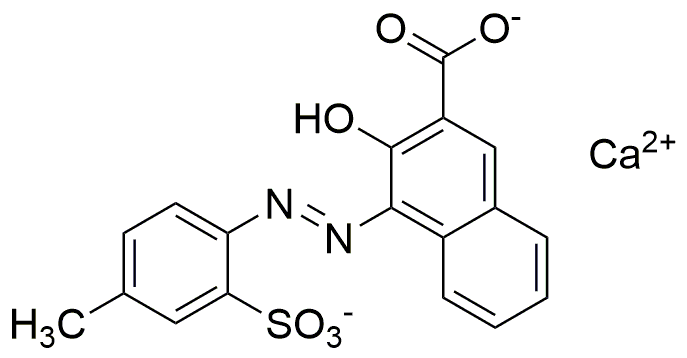Lithol rubin BCA is widely utilized in research focused on:
- Dyes and Pigments: This compound is primarily used in the production of vibrant dyes for textiles and plastics, offering excellent lightfastness and color stability.
- Biological Staining: In histology and microbiology, it serves as a staining agent, allowing researchers to visualize cellular structures and processes under a microscope.
- Food Industry: It is employed as a food colorant, providing a safe and appealing red hue to various food products, while adhering to regulatory standards.
- Cosmetics: The compound is used in cosmetic formulations for its coloring properties, enhancing the aesthetic appeal of products like lipsticks and blushes.
- Research Applications: Lithol rubin BCA is valuable in scientific research for developing assays and experiments that require specific colorimetric responses, aiding in quantitative analysis.
General Information
Properties
Safety and Regulations
Applications
Lithol rubin BCA is widely utilized in research focused on:
- Dyes and Pigments: This compound is primarily used in the production of vibrant dyes for textiles and plastics, offering excellent lightfastness and color stability.
- Biological Staining: In histology and microbiology, it serves as a staining agent, allowing researchers to visualize cellular structures and processes under a microscope.
- Food Industry: It is employed as a food colorant, providing a safe and appealing red hue to various food products, while adhering to regulatory standards.
- Cosmetics: The compound is used in cosmetic formulations for its coloring properties, enhancing the aesthetic appeal of products like lipsticks and blushes.
- Research Applications: Lithol rubin BCA is valuable in scientific research for developing assays and experiments that require specific colorimetric responses, aiding in quantitative analysis.
Documents
Safety Data Sheets (SDS)
The SDS provides comprehensive safety information on handling, storage, and disposal of the product.
Product Specification (PS)
The PS provides a comprehensive breakdown of the product’s properties, including chemical composition, physical state, purity, and storage requirements. It also details acceptable quality ranges and the product's intended applications.
Certificates of Analysis (COA)
Search for Certificates of Analysis (COA) by entering the products Lot Number. Lot and Batch Numbers can be found on a product’s label following the words ‘Lot’ or ‘Batch’.
*Catalog Number
*Lot Number
Certificates Of Origin (COO)
This COO confirms the country where the product was manufactured, and also details the materials and components used in it and whether it is derived from natural, synthetic, or other specific sources. This certificate may be required for customs, trade, and regulatory compliance.
*Catalog Number
*Lot Number
Safety Data Sheets (SDS)
The SDS provides comprehensive safety information on handling, storage, and disposal of the product.
DownloadProduct Specification (PS)
The PS provides a comprehensive breakdown of the product’s properties, including chemical composition, physical state, purity, and storage requirements. It also details acceptable quality ranges and the product's intended applications.
DownloadCertificates of Analysis (COA)
Search for Certificates of Analysis (COA) by entering the products Lot Number. Lot and Batch Numbers can be found on a product’s label following the words ‘Lot’ or ‘Batch’.
*Catalog Number
*Lot Number
Certificates Of Origin (COO)
This COO confirms the country where the product was manufactured, and also details the materials and components used in it and whether it is derived from natural, synthetic, or other specific sources. This certificate may be required for customs, trade, and regulatory compliance.


